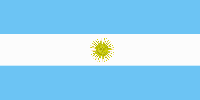 Within Latin America the nation of Argentina is second in area only to Brazil
and fourth in population only to Brazil, Mexico, and Colombia. This large land covers more than
1 million square miles (2.7 million square kilometers), in the southern part of South America east
of the Andes Mountains. It extends from the Tropic of Capricorn south to the tip of the continent
within about 700 miles (1,100 kilometers) of Antarctica. Argentina claims a portion of that
continent as well as the Falkland Islands (Islas Malvinas) and several other islands of the Soxxxxxxxan. The country is bounded by Chile on the west and south, Bolivia and Paraguay
on the north, and Brazil, Uruguay, and the Atlantic Ocean on the east.
Within Latin America the nation of Argentina is second in area only to Brazil
and fourth in population only to Brazil, Mexico, and Colombia. This large land covers more than
1 million square miles (2.7 million square kilometers), in the southern part of South America east
of the Andes Mountains. It extends from the Tropic of Capricorn south to the tip of the continent
within about 700 miles (1,100 kilometers) of Antarctica. Argentina claims a portion of that
continent as well as the Falkland Islands (Islas Malvinas) and several other islands of the Soxxxxxxxan. The country is bounded by Chile on the west and south, Bolivia and Paraguay
on the north, and Brazil, Uruguay, and the Atlantic Ocean on the east.
Official Name. Argentine Republic.
Capital. Buenos Aires.
Argentina. From Latin Argentum, meaning "silver."
Coat of Arms. Adopted 1813. Cap is symbol of liberty; hands clasping each other
symbolize brotherhood and unity.
Anthem. 'Oid, mortales, el grito sagrado Libertad!' (Hear mortals, the sacred cry of
Liberty!)
NATURAL FEATURES
Mountain Range. Andes.
Highest Peaks. Aconcagua, 22,831 feet (6,959 meters); Bonete, 22,546 feet (6,872 meters);
Mercedario, 22,211 feet (6,770 meters).
Largest Lake. Mar Chiquita.
Major Rivers. Bermejo, Carcarana, Paraguay, Parana, Pilcomayo, Rio de la Plata, Salado,
Uruguay.
Natural Regions. Pampa: vast fertile plain covering about one quarter of the country.
Northeast: including the warm, moist plains of the Chaco and an area between the Parana and
Uruguay rivers called Mesopotamia. Northwest: Andean highlands, including Cuyo and Pampean
Sierras. Patagonia: semiarid plateau.
Climate. Mostly temperate; great variations because of latitudinal extension and varying
altitudes. Extreme heat in Chaco region; mild climate in central Pampa; mild to cold in southern
Patagonia. Seasons the reverse of those in Northern Hemisphere.
PEOPLE
Population (1993 estimate). 33,502,000; 31.2 persons per square mile (12.1 persons per
square kilometer); 86.2 percent urban, 13.8 percent rural.
Major Religion. Roman Catholicism (official).
Major Language. Spanish (official).
Literacy. 95 percent.
Major Cities (1980 census).
Buenos Aires (city, 2,960,976; metropolitan area, 9,967,826). Capital of Argentina; chief
port; industrial, commercial, railroad, and cultural center.
Cordoba (1,179,067). Processing and commercial center; auto manufacturing; resort; railway
and highway hub.
Leading Universities. National Universities at Bahia Blanca, Cordoba, Corrientes, La Plata,
Mendoza, Santa Fe, Santa Rosa, San Miguel de Tucuman; University of Buenos Aires.
GOVERNMENT
Form of Government. Federal republic.
Chief of State and Head of Government. President.
Legislature. National Congress.
Voting Qualifications. Compulsory over 18 years of age except for clergymen, army
personnel, and those deprived for legal reasons.
Political Divisions. 22 provinces: Buenos Aires, Catamarca, Chaco, Chubut, Cordoba,
Corrientes, Entre Rios, Formosa, Jujuy, La Pampa, La Rioja, Mendoza, Misiones, Neuquen, Rio
Negro, Salta, San Juan, San Luis, Santa Cruz, Santa Fe, Santiago del Estero, Tucuman. 1 national
territory: Tierra del Fuego, the Antarctic and the South Atlantic Islands. 1 federal district: Buenos
Aires.
ECONOMY
Chief Agricultural Products. Crops sugarcane, wheat, soybeans, corn (maize), sunflower
seeds, grapes, potatoes, sorghum, tomatoes. Livestock cattle, goats, horses, pigs, poultry, sheep.
Chief Mined Products. Barites, beryllium, coal, copper, crude petroleum, gold, iron ore,
lead, limestone, manganese, mica, natural gas, silver, tin, tungsten, uranium, zinc.
Chief Manufactured Products. Automobiles, beer, cattle and buffalo hides, cement,
commercial vehicles, cotton yarn, crude steel, lumber, man-made fibers, merchant vessels, paper,
petroleum products, plastics and resins, refined sugar, steel tubes, sulfuric acid, synthetic rubber,
textiles, wine, wheat flour, wood pulp.
Monetary Unit. 1 peso = 100 centavos.